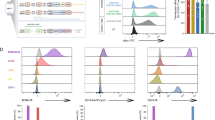Abstract
Introduction
CD44 is a cell adhesion molecule believed to play a critical role in T cell and monocyte infiltration in the inflammatory process. The reduction of CD44 expression or its ability to properly interact with its key ligand, hyaluronic acid (HA), inhibits migration and subsequent activation of cells within sites of inflammation. CD44-deficient mice exhibit decreased disease in a mouse arthritis model.
Methods
Accordingly, we developed PF-03475952, a fully human IgG2 anti-CD44 monoclonal antibody (mAb).
Results
Binding of PF-03475952 to CD44 inhibits binding of HA and induces loss of CD44 from the cell surface. PF-03475952 also passed a series of safety pharmacology assays designed to assess the risk of the mAb to bind Fc gamma receptors, stimulate cytokine release from human whole blood, and stimulate cytokine release from peripheral blood mononuclear cells (PBMC) using plate-bound antibodies. The latter assay was designed specifically to evaluate the risk of cytokine storm that had been observed with TGN1412 (immunostimulatory CD28 superagonist mAb). PF-003475952 exhibits high-affinity binding to both human and cynomolgus monkey CD44, but does not cross-react with rodent CD44. Thus, a rat anti-mouse CD44 mAb was used to demonstrate a dose-dependent decrease of disease in mouse collagen-induced arthritis. Importantly, efficacy was correlated with >50% loss of cell surface CD44 on circulating cells. Loss of CD44 expression on CD3{su+} lymphocytes was monitored following a single dose of PF-03475952 in cynomolgus monkeys as a pharmacodynamic marker. The recovery of CD44 expression was found to be dose-dependent. PF-03475952 doses of 1, 10, and 100 mg/kg reduced CD44 expression below 50% for 218, 373, and >504 hours, respectively.
Conclusion
Targeting of CD44 is a unique mechanism of action in the treatment of inflammatory diseases and is expected to reduce joint damage induced by inflammatory mediators, resulting in disease modification in inflammatory diseases such as rheumatoid arthritis.
Similar content being viewed by others
References
Mikecz K, Brennan FR, Kim JH, Glant TT. Anti-CD44 treatment abrogates tissue oedema and leukocyte infiltration in murine arthritis. Nature Med. 1995;1:558–563.
Mikecz K, Dennis K, Shi M, Kim JH. Modulation of hyaluronan receptor (CD44) function in vivo in a murine model of rheumatoid arthritis. Arthritis Rheum. 1999;42:659–668.
Ponta H, Sherman L, Herrlich PA. CD44: from adhesion molecules to signalling regulators. Nat Rev Mol Cell Biol. 2003;4:33–45.
Stoop R, Kotani H, McNeish JD, Otterness IG, Mikecz K. Increased resistance to collagen-induced arthritis in CD44-deficient DBA/1 mice. Arthritis Rheum. 2001;44:2922–2931.
Bajorath J. Molecular organization, structural features, and ligand binding characteristics of CD44, a highly variable cell surface glycoprotein with multiple functions. Proteins. 2000;39:103–111.
Naor D, Nedvetzki S. CD44 in rheumatoid arthritis. Arthritis Res Ther. 2003;5:105–115.
Brocke S, Piercy C, Steinman L, Weissman IL, Veromaa T. Antibodies to CD44 and integrin alpha4, but not L-selectin, prevent central nervous system inflammation and experimental encephalomyelitis by blocking secondary leukocyte recruitment. Proc Natl Acad Sci U S A. 1999;96:6896–6901.
Katoh S, Matsumoto N, Kawakita K, Tominaga A, Kincade PW, Matsukura S. A role for CD44 in an antigen-induced murine model of pulmonary eosinophilia. J Clin Invest. 2003;111:1563–1570.
Camp RL, Scheynius A, Johansson C, Pure E. CD44 is necessary for optimal contact allergic responses but is not required for normal leukocyte extravasation. J Exp Med. 1993;178:497–507.
Shi M, Dennis K, Peschon JJ, Chandrasekaran R, Mikecz K. Antibody-induced shedding of CD44 from adherent cells is linked to the assembly of the cytoskeleton. J Immunol. 2001;167:123–131.
Kajita M, Itoh Y, Chiba T, et al. Membrane-type 1 matrix metalloproteinase cleaves CD44 and promotes cell migration. J Cell Biol. 2001;153:893–904.
Armour KL, van de Winkel JG, Williamson LM, Clark MR. Differential binding to human FcγRIIa and FcγRIIb receptors by human IgG wildtype and mutant antibodies. Mol Immunol. 2003;40:585–593.
Expert Scientific Group on Phase One Trials. Final report. 30 Nov 2006. http://www.dh.gov.uk/en/Publicationsandstatistics/Publications/PublicationsPolicyAndGuidance/DH_063117. Accessed March 2010.
Stebbings R, Findlay L, Edwards C, et al. “Cytokine Storm” in the phase I trial of monoclonal antibody TGN1412: better understanding the causes to improve preclinical testing of immunotherapeutics. J Immunol. 2007;179:3325–3331.
Suntharalingam G, Perry MR, Ward S, et al. Cytokine storm in a phase 1 trial of the anti-CD28 monoclonal antibody TGN1412. N Engl J Med. 2006;355:1018–1028.
Riechelmann H, Sauter A, Golze W, et al. Phase I trial with the CD44v6-targeting immunoconjugate bivatuzumab mertansine in head and neck squamous cell carcinoma. Oral Oncol. 2008;44:823–829.
Tijink BM, Buter J, de Bree R, et al. A phase I dose escalation study with anti-CD44v6 bivatuzumab mertansine in patients with incurable squamous cell carcinoma of the head and neck or esophagus. Clin Cancer Res. 2006;12:6064–6072.
Author information
Authors and Affiliations
Corresponding author
Rights and permissions
About this article
Cite this article
Runnels, H.A., Weber, G.L., Min, J. et al. PF-03475952: a potent and neutralizing fully human anti-CD44 antibody for therapeutic applications in inflammatory diseases. Adv Therapy 27, 168–180 (2010). https://doi.org/10.1007/s12325-010-0010-0
Received:
Published:
Issue Date:
DOI: https://doi.org/10.1007/s12325-010-0010-0




